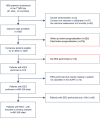The predictive value of highly malignant EEG patterns after cardiac arrest: evaluation of the ERC-ESICM recommendations
- PMID: 38172300
- PMCID: PMC10811097
- DOI: 10.1007/s00134-023-07280-9
The predictive value of highly malignant EEG patterns after cardiac arrest: evaluation of the ERC-ESICM recommendations
Abstract
Purpose: The 2021 guidelines endorsed by the European Resuscitation Council (ERC) and the European Society of Intensive Care Medicine (ESICM) recommend using highly malignant electroencephalogram (EEG) patterns (HMEP; suppression or burst-suppression) at > 24 h after cardiac arrest (CA) in combination with at least one other concordant predictor to prognosticate poor neurological outcome. We evaluated the prognostic accuracy of HMEP in a large multicentre cohort and investigated the added value of absent EEG reactivity.
Methods: This is a pre-planned prognostic substudy of the Targeted Temperature Management trial 2. The presence of HMEP and background reactivity to external stimuli on EEG recorded > 24 h after CA was prospectively reported. Poor outcome was measured at 6 months and defined as a modified Rankin Scale score of 4-6. Prognostication was multimodal, and withdrawal of life-sustaining therapy (WLST) was not allowed before 96 h after CA.
Results: 845 patients at 59 sites were included. Of these, 579 (69%) had poor outcome, including 304 (36%) with WLST due to poor neurological prognosis. EEG was recorded at a median of 71 h (interquartile range [IQR] 52-93) after CA. HMEP at > 24 h from CA had 50% [95% confidence interval [CI] 46-54] sensitivity and 93% [90-96] specificity to predict poor outcome. Specificity was similar (93%) in 541 patients without WLST. When HMEP were unreactive, specificity improved to 97% [94-99] (p = 0.008).
Conclusion: The specificity of the ERC-ESICM-recommended EEG patterns for predicting poor outcome after CA exceeds 90% but is lower than in previous studies, suggesting that large-scale implementation may reduce their accuracy. Combining HMEP with an unreactive EEG background significantly improved specificity. As in other prognostication studies, a self-fulfilling prophecy bias may have contributed to observed results.
Keywords: Brain injury; Cardiac arrest; Coma; EEG; Outcome; Prognosis.
© 2024. The Author(s).
Conflict of interest statement
CS is Associate Editor of Intensive Care Medicine. All the other authors report no disclosures relevant to this manuscript.
References
-
- Lemiale V, Dumas F, Mongardon N, Giovanetti O, Charpentier J, Chiche JD, Carli P, Mira JP, Nolan J, Cariou A. Intensive care unit mortality after cardiac arrest: the relative contribution of shock and brain injury in a large cohort. Intensive Care Med. 2013;39:1972–1980. doi: 10.1007/s00134-013-3043-4. - DOI - PubMed
-
- Dragancea I, Wise MP, Al-Subaie N, Cranshaw J, Friberg H, Glover G, Pellis T, Rylance R, Walden A, Nielsen N, Cronberg T, investigators TTMt, Protocol-driven neurological prognostication and withdrawal of life-sustaining therapy after cardiac arrest and targeted temperature management. Resuscitation. 2017;117:50–57. doi: 10.1016/j.resuscitation.2017.05.014. - DOI - PubMed
MeSH terms
LinkOut - more resources
Full Text Sources
Medical
Research Materials


